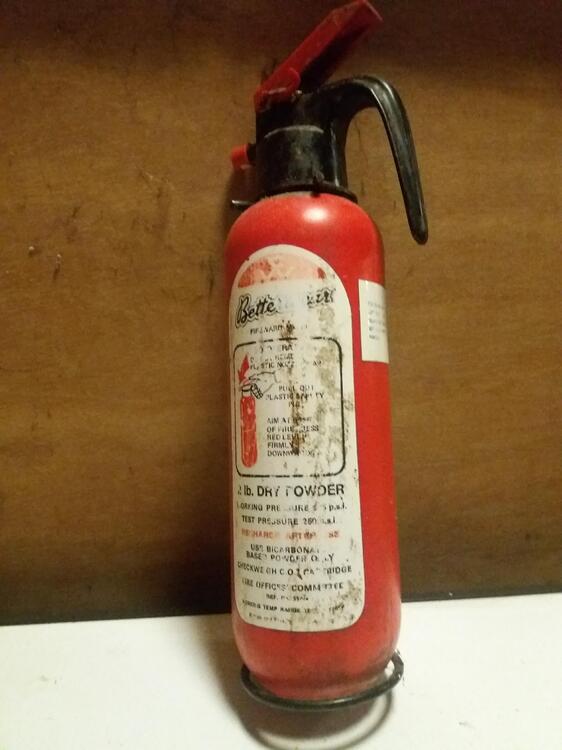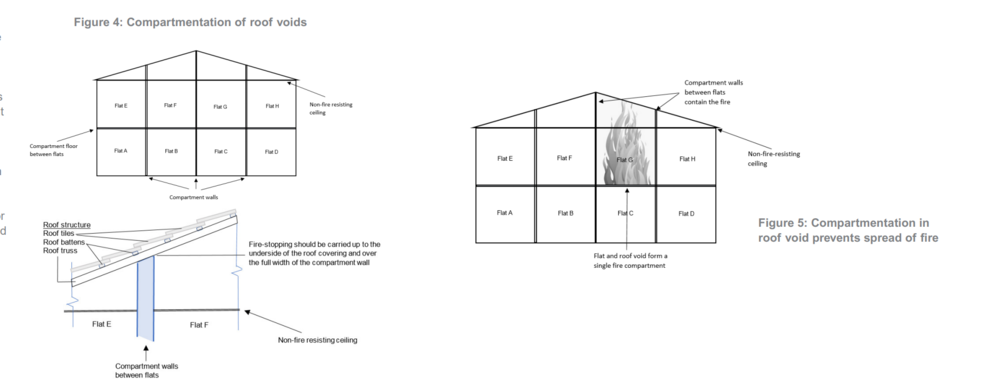-
Posts
2,328 -
Joined
-
Last visited
Everything posted by AnthonyB
-
The chains are not required anymore and usually Building Regulations only require you to not make conditions worse than under the original Building Regulations approval so like for like would be OK - however the addition of the intumescent strips would be preferred as it vastly increases the efficacy of the door (assuming it's closed!)
-
The Fireward brand of plastic bodied cartridge operated powder extinguisher was very popular in both the commercial and domestic/leisure/motoring markets with tens of thousands sold under various distributor brands including Betterware, Chubb, Angus and many more. However the natural decay and aging of plastic, particularly where subject to external factors including UV from sunlight, was found to make the shell brittle - furthermore impact damage could cause tiny fractures that could not be readily visually detected. Thus they could sit there fine until operated when they would be subject to a rapid rise in pressure and if the shell or headcal/valve was in any way compromised then there could be a rupture or ejection of parts. Pressure testing could not be carried out readily unlike with steel & aluminum cylinders - also with steel cylinders degradation is readily seen (rust!), so ultimately the model was discontinued (there was also a move away from cartridge extinguishers to stored pressure extinguishers which helped push things along) and for the last 20 years or so servicing standards have required non metal bodied extinguishers to be declared obsolete, not serviced and replaced unless made after 2002 (when more modern synthetic materials such as Kevlar had been developed for pressure vessel use)
-
Usually for lofts instead of fire resistant ceilings below you continue all the fire rated walls below up to roof eaves level:
-
You will need Building Regulations approval for this change. Local Authority Building Control may: - Reject the plans - Require changes in fire protection (e.g. higher category of fire alarm, sprinklers, fire curtains and similar) - Accept them as they are They may accept it as it is if both of the following apply. i. The travel distance from the flat entrance door to any point in any habitable room is a maximum of 9m. ii. Cooking facilities are remote from the main entrance door and do not impede the escape route from anywhere in the flat. Otherwise they may require sprinklers and an LD1 fire alarm system (smoke & heat alarms throughout the whole flat)
-
The shop will require a fire risk assessment under the current legislation, which in addition to considering fire safety within the shop needs to consider the effect of a fire on the flats above, requiring: - Suitable fire resisting construction between the shop & flat above; or - Fire detection in the shop linked to sounders in the flats above It's preferred to have the fire separation as oppose to linked alarms. The flats, if they have an internal communal area, will also need a fire risk assessment of the common parts in addition to complying with the Housing Act (which is of more relevance if rented out not owner occupied) The exact fire precautions required come out of the findings of the fire risk assessment.
-
300mm. Both of those are in dead space and would either activate slowly or not at all, however the light fitting is a large obstruction requiring suitable spacing and if it's a small lobby there may be no ideal location and the current one is the best of a bad lot.
-
Depends on the type of building, what country you are in and what guidance you follow. Plenty of 30 min cupboards out there which are fine. There is often a difference between requirements for the design of a new building and those for existing ones built to legacy codes.
-
Yes would need to see it to be sure. The minimum is Category M, layout and the desire for property protection would determine what/if detection is required.
-
If it's empty for any significant period I will justify the non provision of equipment in the FRA and environmentally dispose of it. It is assessed on a case by case basis though and in some situations certain strategic provision may remain. If it's staying in place it needs to be serviced, so more often than not the client goes for removal and off I go with them. Insurers don't usually object but should be consulted.
-

Fire Risk Assessments during the COVID outbreak
AnthonyB replied to a topic in Fire Risk Assessments
Unlike earlier in the year there is no essential work only lockdown in England. Only specified sectors are forcibly closed and the others are expected to work, the only requirement being that where the job can be done from home it is. Covid does not stop fires occurring and whilst some RP's have postponed FRAs because of the reasons you cite others are keeping going with their program. Many are having to revise their FRA because of the Covid situation due to significant changes in the risk in the premises and the persons at risk resulting from measures to be COVID secure. If the premises are due a review, it should continue. If not then why would they do it even if there wasn't Covid? If you are in the ultra high risk group then there is a case for you not working and being able to claim the resultant benefits or seeing if you can be furloughed, if not then the contractual requirement to work (if there is work to be done) remains. -
Instead of going through an Alarm Receiving Centre? Fire alarms haven't been directly connected to equipment in fire service control rooms for a very long time.
-
Normally bathrooms and toilets opening onto protected stairways do not require fire doors unless containing an additional fire risk (e.g. a boiler) - however current Building Regulations as applicable to dwellings don't have this clause in so arguably all the doors should be fire doors. As such as conversion requires Building Regulations approval (distinct from Planning Permission) then LABC or your Approved Inspector should have stated if the door needed changing or not and if they did not require it at the time (by a sensible interpretation of the guidance) then you are fine.
-
Simple answer - no. Breaches both fire and H&S legislation.
-

Means of Escape from Blocks of Flats - Ground Floor Only
AnthonyB replied to Jonny Roberts's topic in Fire Risk Assessments
Do the flats not have means of escape windows? If modern then Approved Document B or BS9991 will have been used at the time of build. -
No. To test awareness of other routes staff can be advised that a particular route is 'blocked' by fire (a situation anticipated in the Building Regulations when it comes to escape route provision) but it would be wrong to actually lock a route.
-
Both apply. BS8524 covers the design and installation of the curtain, BS EN1634 covers the fire and smoke tests that the curtain should be subject to and pass.
-
That's up to the Responsible Person and their FRA - plus Building Control if carrying out alterations.
-
They need to be trained appropriately to their expected role, which would include ensuring the safe evacuation of the store, however there is nothing to say this has to be an external course, training can be in house as long as it's adequate, particularly if a small lower risk business.
-
The full rated duration of the fittings - which these days is almost universally 3 hours.
-
If you don't need a key on the inside to open the door, which with a Yale night latch you don't, and it can't be snibbed shut, then it's fine on an existing building. It's only an issue if you need a key to get out, not to get in. If they wanted the upper floor to have extra privacy and security, then it's not an issue, the premises sound like they have gone through the s257 process by the fact of having the full communal alarm so were accepted as they are.
-
Are you in Scotland? That's the only area where there has been a change to the law. In the rest of the UK the law hasn't changed, only the British Standard for Residential Fire Alarms (BS5839-6:2019), which is not law and not retrospective. The let out flats still only need a Grade F LD3 system (battery only smoke alarm to the hall) although it would be best practice to be Grade D LD2 (mains & battery interlinked, hall, kitchen and principle habitable room) and if you have a rewire you will be upgraded to this standard. Owner occupied can do what they want (including having nothing) As for your specific situation, the system covering the flats with the common areas as required under s257 remains legal as there is no retrospective requirement to extend. The flats not on the common system should not need including if never on before as the assumption is they are suitably fire separated from the other part of the building so as not to have needed inclusion - they therefore only need self contained detection if let out and strongly advise self contained detection if owner occupied. Sounds like someone is trying to make a few quid! I can't be definitive without seeing the site, but even if (Unlikely) something needs adding it doesn't sound right the way they've said.
- 34 replies
-
- flats
- self contained
-
(and 1 more)
Tagged with:
-
In most cases toilets do not require fire doors anyway and so single cubicle toilets of any type don't have self closers, larger ones have them more for ventilation control/privacy.
-

Fire Door Removal in older 3-storey property
AnthonyB replied to a topic in Fire Doors and Accessories
You are looking at the wrong register (there is more than one!) https://www.ifsm.org.uk/fra-registers/assessors/buck-anthony-charles/ -

Fire Door Removal in older 3-storey property
AnthonyB replied to a topic in Fire Doors and Accessories
I'm on the Nationally Accredited Fire Risk Assessors Register (NAFAR). -

Do I need to fit a fire door between garage and utility room?
AnthonyB replied to a topic in Fire Doors and Accessories
You will require Building Control approval for this work (it's not exempt as Building Regulations are not the same as Planning Permission & permitted development doesn't remove the requirement for Building Regulations compliance) As part of this a fire door will be required for Part B compliance, not sure about the step, will depend on the change of level and comes under Part M.



